Opportunities and Challenges for Preschool Expansion
State boards can steer their states through thorny questions of pre-K access, quality, funding, and continuous improvement.


For two decades, the state role in educating children before kindergarten has been growing, and it is accelerating. Once minor players, state-funded preschools saw their enrollment grow from just 700,000 in 2001 to 1.66 million in 2019, the pre-pandemic high.[1] Enrollment in state-funded preschool today far exceeds that in federal Head Start, and states are the dominant provider at age 4, serving about half of all four-year-olds who attend any preschool program. New universal preschool initiatives in states around the country are poised to generate an unprecedented boom in state-funded preschool over the next decade.
High-quality preschool programs can produce strong short- and long-term benefits to children and taxpayers.[2] Children’s “hard” and “soft” skills—language, literacy, math, science, and social and emotional development—improve in the short run. In the long term, they see increased achievement, better classroom behavior, less grade retention and special education, reduced delinquency and crime, and increased educational attainment. These outcomes, in turn, improve students’ employment and earnings, health, and even how long they live.[3]
To ensure that programs deliver these outcomes, state policymakers must attend to access, quality, funding, and supports for continuous improvement. As state-funded programs expand, state boards of education will face demands to address complex policy issues that may not have come up before. State policies differ greatly, and states have much to learn from each other and from a survey of the state preschool landscape.
Increasing Access
Because statistical systems differ in the age ranges and definitions they use, preschool enrollment is hard to pinpoint. Our institute’s best estimate is that just over 60 percent of all children who are ages 3 to 5 and not yet in kindergarten attend a formal preschool program.[4] For three- and four-year-olds alone, enrollment is about 53 percent.[5] In any case, preschool enrollment plateaued about 20 years ago and then decreased during the pandemic before returning to prior levels.[6] Enrollment is higher at age 4 (67 percent) than at 3 (40 percent).[7] State-funded preschool programs enrolled 35 percent of four-year-olds and 7 percent of three-year-olds in 2023.[8]
National averages conceal a great deal of variation in enrollment by income, race, and state.[9] Enrollment is highly unequal by income. Three- and four-year-olds with annual family incomes below $20,000 have the lowest enrollment (40 percent). Most children in poverty do not attend a preschool program, public or private, at ages 3 and 4. Those with annual family incomes above $75,000 enrollment have the highest enrollment (60 percent). Hispanic children are least likely to enroll.
Vermont and the District of Columbia offer preschool to all three- and four-year-olds. Idaho, Indiana, Montana, New Hampshire, South Dakota, and Wyoming do not yet provide preschool education except to children with special needs.[10]
Table 1 reports the percentages of children served in each state’s preschool program at each age, in rank order based on the percentage served at age 4, as this accounts for the vast majority served. Ten states serve the majority of their four-year-olds, and more are poised to join them. New preschool for all laws have been passed in California, Colorado, New Mexico, and Hawaii, and governors in Illinois, Michigan, and New Jersey have launched new initiatives.
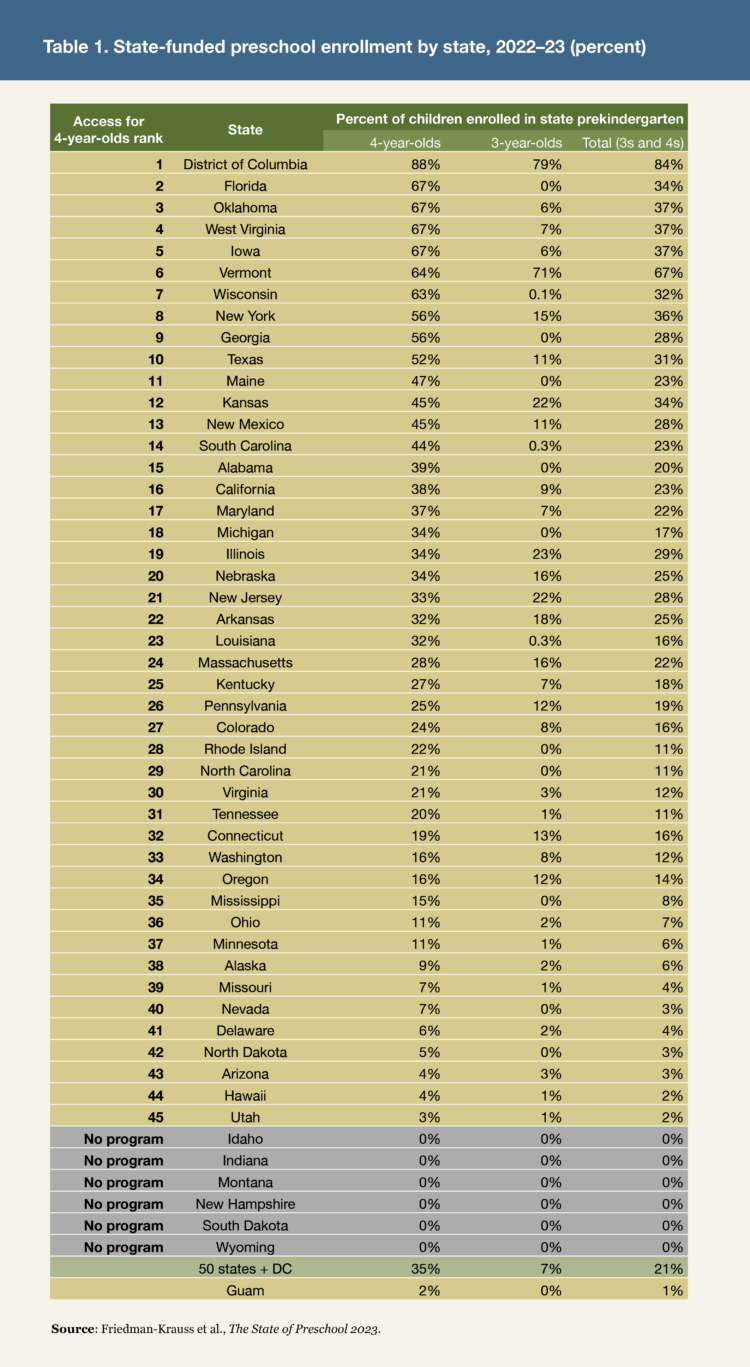
State universal preschool policies do not always ensure high enrollment rates or even that all children are offered a place in the state program. Some states have struggled to keep the promises they made to offer preschool for all, and state boards could play an important role in putting this issue back on the agenda in states where it has fallen off. Preschool for all requires legislating preschool as an entitlement and ensuring that adequate funding follows enrollment. Instead, annual appropriations have often dictated limitations to enrollment.
Preschool for all requires legislating preschool as an entitlement and ensuring that adequate funding follows enrollment.
State boards also can put expansion on the agenda in states that have not committed to preschool for all. Most states could benefit from a study or hearing on the need for preschool education. In addition to the six states with no program, eight others serve less than 10 percent of their four-year-olds. Just ten serve more than half.
Of course, state-funded preschool is not the only option, and Head Start serves many children in some states. However, Head Start enrollment has been shrinking.[11] For example, before the pandemic Head Start in Mississippi enrolled about 90 percent of three- and four-year-olds in poverty. By 2021, Head Start enrollment had declined to enrollment of 54 percent of these children.[12] Declining Head Start enrollment is one reason that access to preschool programs overall, public and private, has barely increased in 20 years even while state preschool enrollment more than doubled.[13]
The next 10 years will present an unprecedented opportunity for many states to expand enrollment in what might be viewed as a revenue-neutral way.
The next 10 years will present an unprecedented opportunity for many states to expand enrollment in what might be viewed as a revenue-neutral way—that is, requiring no new taxes. Between 2021 and 2031, the K-12 population is projected to decline by 5.1 percent nationally.[14] Projected enrollment declines in some states will exceed 10 percent; others will have more modest declines (figure 1). A few states will see increases. States with large projected declines could make preschool for all a reality in the next decade without any real changes in tax rates and revenues. As demographic change will vary so much from state to state, every state board member should know their state’s enrollment projections. States that could add an entire “new grade” at age 4 with just the cost savings from declining K-12 enrollment of 7.7 percent or more are shown in figure 1.
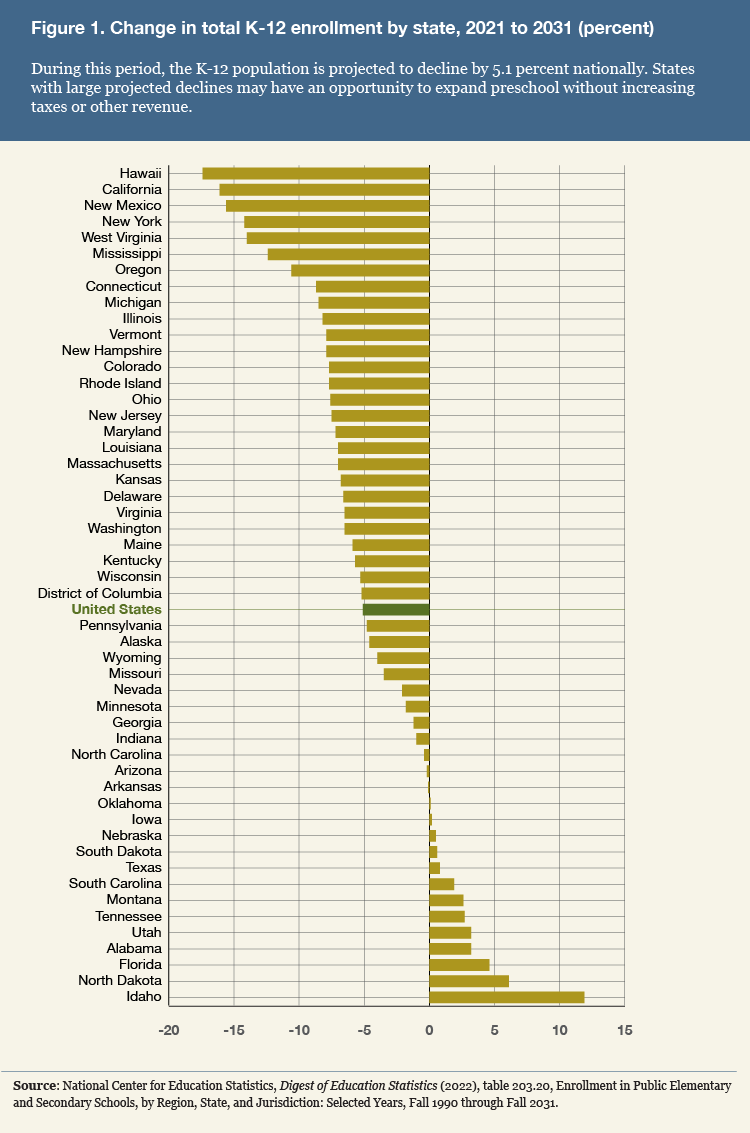
Raising Quality
The standards that support quality in state-funded preschool programs vary as much from state to state as enrollment does. The National Institute for Early Education Research (NIEER) surveys states annually on their policies to support quality and compares each state against 10 benchmarks that characterize effective programs.[15] Programs meeting all 10 benchmarks are not necessarily all effective; policies could be inadequately funded or poorly implemented. Conversely, programs that meet or surpass nearly all the standards but barely miss one or two might surpass programs that barely meet all 10. Nevertheless, it is useful to have these indicators of what states should strive for—at a minimum—if their programs are to be educationally effective.
The 10 benchmarks are listed in table 2, which also reports the number of state programs (many have several). Half focus on structural features (e.g., class size), and half focus on process (e.g., in-class coaching and supports for curriculum selection and implementation). While state programs overwhelmingly meet many of the standards, others are less frequently met. Among the most rarely met are requiring all teachers to have a four-year college degree (as for K-12 teachers), providing coaching, and requiring an early childhood qualification for the assistant teacher, which would facilitate true team teaching. Sadly, 11 state-funded preschool programs that enroll 37 percent of the nation’s young children enrolled in preschool meet fewer than half the benchmarks.
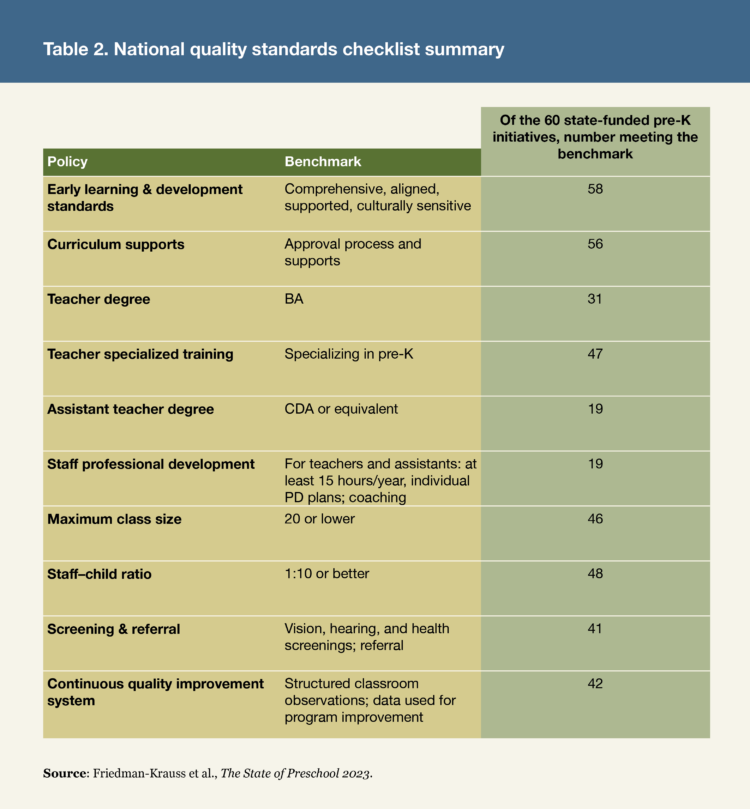
State boards can convey to the public and other elected officials the need for quality in preschool comparable to that in K-12. Nearly every state has adopted early learning and development standards that set high expectations for learning and teaching in preschool. High standards for teacher and assistant teacher qualifications should follow. But as table 2 shows, many states require neither a bachelor’s degree of all preschool teachers nor an entry-level child development associates credential (CDA) for assistants. Perhaps more states would adopt higher qualifications for teaching staff and pay comparable to that in K-12 if the public and elected officials were made aware of their state’s early learning standards.
State boards can convey the need for quality in preschool comparable to that in K-12.
The goals and content of quality preschool are more than “glorified babysitting” and much richer than the commonly heard “learning their ABC’s and numbers.” Teaching preschool-age children is pedagogically complex as well. Teaching one on one and in small groups is essential. Good preschool teachers understand what each child in the class needs next to progress in each domain of learning and development—cognitive, linguistic, social, emotional, and physical—as well as to foster such dispositions as curiosity, creativity, and resilience. Thus, in addition to requiring highly qualified teachers, states need to limit class size.
Funding Adequately
Adjusted for inflation, state preschool program funding per child has changed little in two decades. By comparison, inflation-adjusted K-12 funding per child has increased steadily. Today, states spend about $7,300 per child enrolled in preschool compared with about $8,000 per child enrolled in K-12. With local and federal spending added in, K-12 funding exceeds $18,000 per child as a national average, but the comparable figure for preschool is only about half that amount. Another indicator of the funding gap is the difference in salaries between kindergarten and preschool teachers in state preschool. Preschool teachers tend to be paid far less, and in mixed delivery systems where some teachers work for private providers, the preschool teachers and other staff often do not receive comparable fringe benefits such as health insurance or retirement as well as being paid less than those working for public schools.[16]
State funding per child for preschool varies greatly by state. This variation reflects differences in many factors, including state cost of living and whether there is an expected local share. It also reflects differences in political will and program design. As many states cannot report local contributions to preschool funding, it is difficult to get an accurate picture of how much full spending differs by state. Figure 2 reports state preschool spending per child adjusted for differences in cost of living. State spending per child still varies greatly after this adjustment. Not all the top spenders are wealthy states. Alabama, Arkansas, New Mexico, and West Virginia are well above the median state. Alabama renamed “Voluntary Alabama Preschool Program” to “First Class” to recognize its quality and adequate funding.
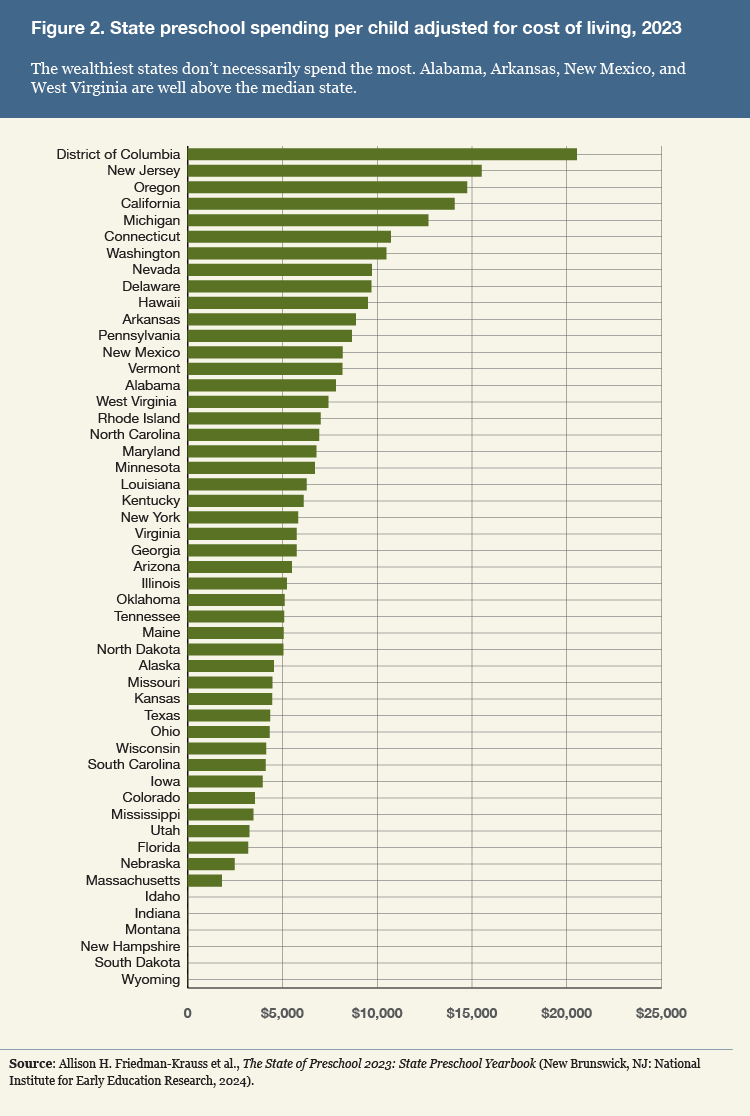
One advantageous approach to funding preschool is to use a funding formula, as is done for K-12. Some universal preschool states, such as Oklahoma and Wisconsin, include preschool in their formulas as just one more grade in public education. Typically, K-12 funding formulas require a local share, with the state share varying with child risk factors and local fiscal capacity. This approach puts preschool on an even playing field with K-12 and ensures funding varies to meet local needs. It also increases funding stability; preschool funding declined less in formula-funded states when the Great Recession hit state budgets.[17]
One advantageous approach to funding preschool is to use a funding formula, as is done for K-12.
Improving Outcomes
Not all public preschool programs have delivered the promised results. In particular, long-term improvements in educational outcomes have not always followed.[18] On the one hand, rigorous evaluations have found positive long-term outcomes for New Jersey’s well-funded, intensive preschool program and for highly lauded programs in Boston and Tulsa.[19] On the other hand, preschool programs have not yielded the same outcomes in Tennessee and elsewhere.[20]
Although multiple explanations have been offered for preschool programs failing to deliver and the relative importance of each factor is uncertain, policymakers can take three obvious steps to increase the likelihood of success.[21] First, ensure that children with the greatest needs (e.g., in poverty, with parents who have not completed high school, homeless) and therefore the greatest potential to benefit can enroll and attend.[22] Children who do not attend cannot benefit. Second, design programs with high expectations and high quality and adequately fund them.[23] Third, and most difficult, create continuous improvement systems to help preschool programs avoid implementation failure, which can afflict even the best designed and funded programs.[24]
Preventing implementation failure requires a shift from traditional “name and blame” accountability to a continuous improvement approach. Think of a continuous improvement system (CIS) as being like a GPS. It tells users where they are and gives them step-by-step directions on how to reach their goal. If they wander off course, it redirects them. Such a CIS requires self-assessment and feedback (e.g., coaching) at classroom, district, and state levels. Rigorous evaluation to validate self-assessment must be part of the CIS. State board support for continuous improvement begins by asking questions and demanding answers about where preschool programs are with respect to quality and outcomes. In many states, the response to those questions will be that no one really knows.
State board support for continuous improvement begins by asking questions and demanding answers about where preschool programs are with respect to quality and outcomes.
Fortunately, rigorous evaluations can be conducted at modest cost applying state-of-the-art statistical methods. Quality assessment for ongoing improvement through coaching can be embedded in regular practice, while quality assessment for evaluation can be accomplished by sampling only a fraction of classrooms. Outcome evaluations can use existing state assessments and other data, such as high school graduation and college attendance rates, with rigorous statistical methods and research designs—perhaps leveraging lotteries for enrollment to mimic randomized experiments. Such studies will permit reasonable estimates of preschool’s true effects on outcomes.
Support for preschool program development, implementation, a CIS, and evaluation requires state capacity. To elected officials this just sounds like more bureaucracy, but state boards can help educate them about the need for building capacity to ensure program effectiveness. Districts need these sorts of support from state agencies:
- assistance interpreting state standards for learning and teaching;
- guidance in selecting and implementing with fidelity an evidence-based curriculum;
- tools to self-evaluate quality and outcomes;
- help designing and implementing evaluations of quality and outcomes;
- model contracts and other assistance contracting with private providers;
- professional learning communities of district-level early childhood supervisors,
- coordinated funding, policies, and services across regular education, special education, and child care; and
- help creating alignment and continuity of teaching methods and content from preschool through K-12.
Final Thoughts
Great opportunities and challenges lie ahead for state boards that seek to improve children’s early education and long-term educational success. While the opportunities and challenges vary by state, every state will need to address enrollment, quality standards, funding adequacy, evaluation and continuous improvement, state capacity, and alignment with K-12. Boards will need all the tools at their disposal to become informed, raise questions, set agendas, and develop policies to benefit children, families, and taxpayers many decades into the future.
Steven Barnett is senior co-director of the National Institute for Early Education Research and Board of Governors Professor at Rutgers University’s Graduate School of Education. Allison Friedman-Krauss is an assistant research professor at the National Institute for Early Education Research at Rutgers University’s Graduate School of Education.
Notes
[1] Allison H. Friedman-Krauss et al., The State of Preschool 2023: State Preschool Yearbook (New Brunswick, NJ: National Institute for Early Education Research, 2024).
[2] W. Steven Barnett, “Effectiveness of Early Educational Intervention,” Science 333 (2011): 975–78; Dana Charles McCoy et al., “Impacts of Early Childhood Education on Medium- and Long-Term Educational Outcomes,” Educational Researcher 46, no. 8 (2017): 474–87.
[3] Robert A. Hahn and W. Steven Barnett, “Early Childhood Education: Health, Equity, and Economics,” Annual Review of Public Health 44 (2023): 75–92.
[4] Jiashan Cui and Luke Natzke, “Early Childhood Program Participation: 2019,” NCES 2020-075REV (Washington, DC: National Center for Education Statistics, Institute of Education Sciences, U.S. Department of Education, 2021).
[5] U.S. Census Bureau, Current Population Survey, Table 3, Nursery and Primary School Enrollment of People 3 to 6 Years Old, by Control of School, Attendance Status, Age, Race, Hispanic Origin, Mother’s Labor Force Status and Education, and Family Income: October 2022 (2023).
[6] National Center for Education Statistics, Digest of Education Statistics, Table 202.10, Enrollment of 3-, 4-, and 5-Year-Old Children in Preprimary Programs, by Age of Child, Level of Program, Control of Program, and Attendance Status: Selected Years, 1970 through 2018 (2019); Jacob Fabina, Erik L. Hernandez, and Kevin McElrath, “School Enrollment in the United States: 2021 American Community Survey Reports” ACS-55 (Washington, DC: U.S. Census Bureau, 2023); Adrienne Griffiths, “School Enrollment Rates of 3- and 4-Year-Olds Returned to Pre-Pandemic Levels in 2022” (U.S. Census Bureau, November 14, 2023).
[7] Unpublished analyses of data from NIEER national 2023 Preschool Learning Activities survey.
[8] Friedman-Krauss et al., State of Preschool 2022.
[9] Census Bureau, Current Population Survey, Table 3.
[10] Friedman-Krauss et al., State of Preschool 2022.
[11] Office of Head Start, Head Start Funding and Funded Enrollment History, figure 2 (2023).
[12] Annie E. Casey Foundation, Kids Count Data Center, web page.
[13] National Center for Education Statistics, Digest of Education Statistics, Table 202.10; Census Bureau, Current Population Survey, Table 3.
[14] National Center for Education Statistics, Digest of Education Statistics, Table 203.20, Enrollment in Public Elementary and Secondary Schools, by Region, State, and Jurisdiction: Selected Years, Fall 1990 through Fall 2031 (2023).
[15] Friedman-Krauss et al., State of Preschool 2022.
[16] Alex Kilander, Karin Garver, and W. Steven Barnett, “Unworthy Wages: State-Funded Preschool Teacher Salaries and Benefits,” research report (New Brunswick, NJ: National Institute for Early Education Research, May 2022).
[17] W. Steven Barnett and Richard Kasmin, “Fully Funding Pre-K through K-12 Funding Formulas,” State Education Standard 18, no . 1 (2018).
[18] Deborah Phillips et al. “Puzzling It Out: The Current State of Scientific Knowledge on Pre-Kindergarten Effects, a Consensus Statement,” research (Washington, DC: Brookings Institution, 2017).
[19] W. Steven Barnett and Kwanghee Jung, “Effects of New Jersey’s Abbott Preschool Program on Children’s Achievement, Grade Retention, and Special Education through Tenth Grade,” Early Childhood Research Quarterly 56 (2021): 248–59, https://doi.org/10.1016/j.ecresq.2021.04.001; Timothy J. Bartik et al., “A Benefit-Cost Analysis of Tulsa Pre-K, Based on Effects on High School Graduation and College Attendance,” Policy Paper No. 2022-029 (Kalamazoo, MI: W.E. Upjohn Institute for Employment Research), https://doi.org/10.17848/pol2022-029; Guthrie Gray-Lobe, G., Parag A. Pathak, and Christopher R. Walters, “The Long-Term Effects of Universal Preschool in Boston,” Quarterly Journal of Economics 138, no. 1 (2023): 363–411, https://doi.org/10.1093/qje/qjac036.
[20] Mark W. Lipsey, Dale C. Farran, and Kelley Durkin, “Effects of the Tennessee Prekindergarten Program on Children’s Achievement and Behavior through Third Grade,” Early Childhood Research Quarterly 45 (2018): 155–76; Timothy J. Bartik and Brad J. Hershbein, “Pre-K in the Public Schools: Evidence from within US States,” Upjohn Institute Working Paper No. 18-285 (2018).
[21] Anamarie A. Whitaker et al., “Why Are Preschool Programs Becoming Less Effective?” EdWorkingPaper 23-885 (Annenberg Institute at Brown University, December 2023), https://doi.org/10.26300/smqa-n695.
[22] Francis A. Pearman, “The Moderating Effect of Neighborhood Poverty on Preschool Effectiveness: Evidence from the Tennessee Voluntary Prekindergarten Experiment,” American Educational Research Journal 57, no. 3 (2020): 1323–57, https://doi.org/10.3102/0002831219872977.
[23] Robert C. Pianta et al., “The Effects of Preschool Education: What We Know, How Public Policy Is or Is Not Aligned with the Evidence Base, and What We Need To Know,” Psychological Science in the Public Interest 10, no. 2 (2009): 49–88.
[24] W. Steven Barnett and Ellen C. Frede, “Long-Term Effects of a System of High-Quality Universal Preschool Education in the United States,” in Hans-Peter Blossfeld et al., eds., Childcare, Early Education and Social Inequality: An International Perspective (Edward Elgar Publishing, 2017).
Also In this Issue
Opportunities and Challenges for Preschool Expansion
By Steven Barnett and Allison Friedman-KraussAs states adopt a bigger role in preschool, state leaders need to be ready to steer through tough questions of quality, access, funding, and continuous improvement.
Universal Pre-K in Tulsa: A Surprising Success
By William GormleyLongitudinal studies of Tulsa’s universal pre-K program reveal benefits to students that persist as they move through elementary and secondary school and on to college.
An Economic Perspective on Preschool for All
By David M. BlauIs “preschool for all” the best way to extend access to preschool to the children who need it most?
State Strategies for Improving Young Children’s Math Skills
By Deborah StipekEarly math instruction is as important to young learners' futures as literacy. It's time for math to get the same level of attention.
California’s Transitional Kindergarten: Lessons Learned
By Anna Powell, Wanzi Muruvi and Brandy Jones LawrenceStates can learn from California's statewide launch of transitional kindergarten, which has impacts on other ECE providers, workforce preparation and compensation, professional development, funding, and program evaluation, as well as implications for system governance.

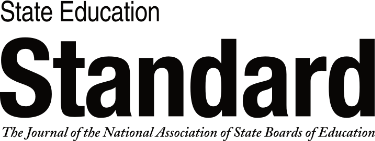






 i
i
 i
i